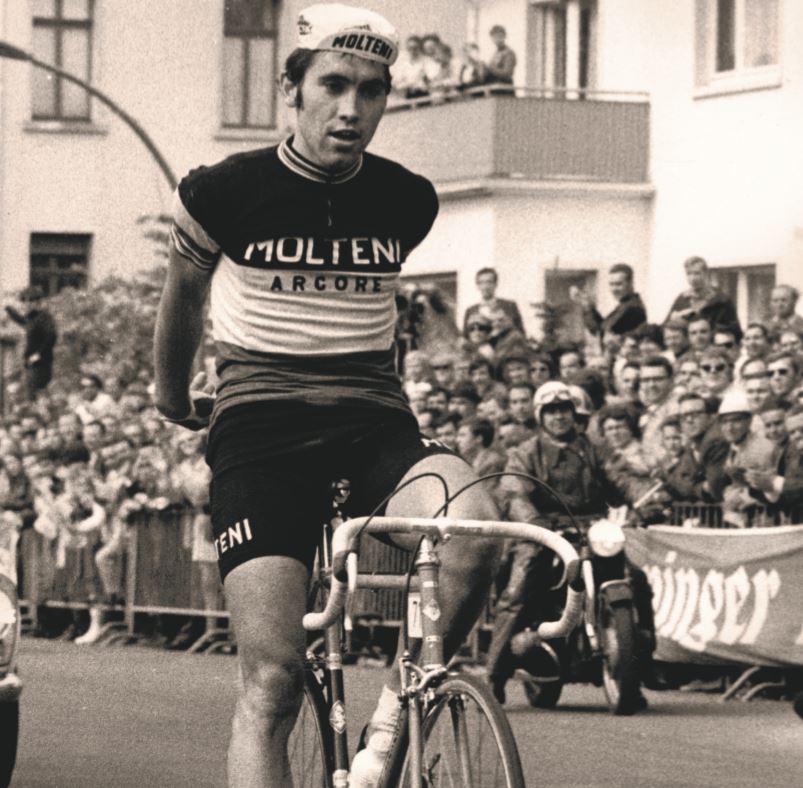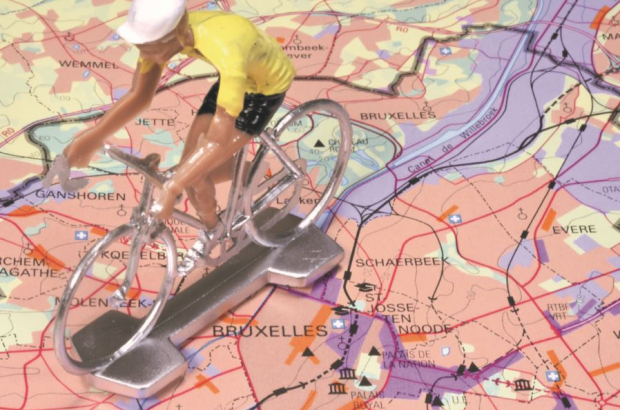- Daily & Weekly newsletters
- Buy & download The Bulletin
- Comment on our articles
Ride on: Share Belgium’s passion for cycling as the Tour de France comes to Brussels
Cycling is something that’s very close to Belgium’s heart, and this summer sees a celebration of the sport as Brussels hosts the start of the world’s biggest cycle race, the Tour de France. Feeling inspired? Large expanses of flat land and gently rolling hills make the country a great place to get into cycling, and while there might be plenty of room for improvement in the capital’s cycle infrastructure and driver behaviour, there have never been more options for city commuters in search of an environmentally friendly way to get to work.
The Grand Depart on 6 July marks the 50th anniversary of the first Tour victory of Brussels’ own Eddy Merckx, the best road cyclist of all time. The Cannibal, as he was nicknamed, would go on to win the Tour four more times. The first stage of this year’s Tour takes the peloton from Brussels via Charleroi back to Brussels, while the day after, the capital is the stage for a team time trial that finishes at the Atomium. While Merckx is no doubt the greatest, Belgium has no shortage of cycling heroes. Icons from the past include Briek Schotte, Rik Van Looy, Roger De Vlaeminck, Lucien Van Impe and the only recently retired Tom Boonen. In the current peloton, Olympic champion Greg Van Avermaet and 2012 world champion Philippe Gilbert are among the biggest names.
A new high-flyer to watch out for is Victor Campenaerts, who recently took cycling’s most prestigious prize: the hour record. This is the record for the longest distance cycled in one hour, alone on a track in a velodrome, without other competitors. Campenaerts was the first rider to exceed the 55kph mark when he cycled a distance of 55.089km in April.
Belgium is also home to some of the most important one-day races of the year, including two of cycling’s five ‘monuments’: the Tour of Flanders, with its cobblestoned climbs, and Liège-Bastogne-Liège, nicknamed La Doyenne (The Old Lady) because it’s the oldest of all the monuments. In winter, Flanders is captivated by cyclo-cross, in which riders traverse mud, sand, hills and other obstacles during several laps of a circuit over about an hour. Another winter spectacle is the Six Days event at Ghent’s Kuipke velodrome, with a varied competition featuring flying lap time trials and Derny races. To understand cycling’s place in Belgium’s psyche, visit the Koers museum in the West Flanders town of Roeselare, while the Tour of Flanders has a visitor centre in Oudenaarde.
Besides being a hotbed of pro cycling talent, Belgium also makes it easy for anyone to get out and explore the Belgian landscape on two wheels themselves. Wallonia has converted more than 1,350km of disused railway lines and canal towpaths into the RAVeL network of comfortable routes ideal for gentle countryside spins. Mostly in Flanders, but increasingly in Wallonia, leisure cyclists can plan routes based on the network of paths marked with numbered junction signs – called knooppunten in Dutch and points-noeuds in French.
Limburg, meanwhile, is promoting itself as a cycling paradise. Apart from many accessible routes, the province is dotted with cycling cafes and cycling-friendly accommodation that offer recreational cyclists the opportunity to rest their legs in facilities designed to meet their needs. And the Cycling Through Water trail near Bokrijk offers a unique experience: a cycle bridge sunken into a lake so that riders traverse it below the water’s surface.

But cycling is not just ideal for weekend escapes: it’s also an efficient and environmentally friendly way to commute or run errands. This is especially common in Flanders – just think of all those bikes you see parked outside Flemish railway stations – and is growing in popularity in the rest of the country.
City dwellers don’t necessarily need their own bike, as bike rental initiatives keep popping up. In Brussels’ streets, cyclists can pick up a bike at one of the many Villo! stations or a Blue-Bike at North, Central, Midi and Luxembourg stations. Via an app, you can also easily track down a nearby electric bike – handy for all those hilly streets – using Billy Bike and new kid on the block Jump, operated by Uber.
Cycling in Brussels is still far from plain sailing, however. Anton Nagolyuk, from Ukraine, has been cycling in the capital practically every day since he arrived here five years ago. He commutes by bike from his home in Molenbeek to his job as a software engineer in Wemmel, and at weekends heads out of the city to explore parks and castles. “I consider myself an experienced cyclist, so I’m quite confident, I’m not afraid when I’m on my bike, but cycling here doesn’t feel safe,” he says. “You so often see cars parked in bike lanes or speeding, and the police don’t act. This aggressive, macho driving happens because drivers feel they won’t be punished.”
In terms of infrastructure, he’s happy with what the region has achieved, given the restrictions of Brussels’ narrow streets, for example – but of course, “the more improvement, the better”. The latest initiative to encourage cycle commuters will see one lane of Rue Belliard in the EU quarter removed and turned into two cycle paths, separated from traffic by concrete bollards.
For those who don’t yet feel comfortable cruising the capital’s streets, non-profit Pro Velo offers its Bike Experience training programme, in which experienced coaches get new cyclists on the right path in a relaxed way. Pro Velo also provides classes in Walloon cities and Antwerp, for both adults and kids, to get everyone riding safely. See www.provelo.org for more details.
Brussels by bike: 5 tips for beginners
- Escape the city for off-road fun on the Sonian forest’s mountain bike trails
- Take a carefree spin alongside the Brussels-Charleroi canal
- Teach the kids how to pedal safely at the Bois de la Cambre at the weekend, when the surrounding road is car-free
- Experience the city from another viewpoint on one of Pro Velo’s themed guided group tours
- Get your bike fixed, or buy a second-hand one, at an atelier of the non-profit Cyclo
What cyclists want
Ahead of Belgium’s elections back in May, the Dutch- and French-speaking cycling associations Fietsersbond and Gracq put forward their priorities for the next governments. Experts Wies Callens of Fietsersbond and Luc Goffinet of Gracq summarise what they believe needs to be done in each of the three regions.
Flanders
Callens: “Flanders should raise its annual investment in cycling infrastructure, amounting to €138 million last year, to about €500 million. That can be done with the current mobility budget, by taking the necessary funds from the part that now goes to support for cars. A clear choice for the bike is necessary to accommodate the different types that are being used more often, such as cargo bikes and speed pedelecs.”
Brussels
Callens: “Nine percent of journeys in Brussels are currently done by bike, which represents a doubling of the percentage in the past five years, but this is despite rather than thanks to policy-makers. We feel this percentage should again be doubled, to 20% under the next government. The government should invest heavily in more secured bicycle parking and really give the public space, dominated by ‘King Car’ since the 1960s, back to cyclists and pedestrians. They must, for example, make car parking more expensive and introduce a zonal toll system.”
Wallonia
Goffinet: “We lost four years because the mobility minister didn’t have a cycling policy plan. We urgently need such a plan and it has to include investments in infrastructure, principally on regional roads, so that people feel safe to cycle everywhere and not just on the recreational RAVeL routes. The speed limit in built-up areas should also be lowered to 30kph. Our polls show that 25% of Walloon people would use a bike regularly if cycling conditions are improved.”
This article first appeared in The Bulletin summer 2019. Top photo: Belpress/Belga. Middle photo: Schimer/Belga




















Comments
Well written, bravo, and thanks for that!
Just one small note: there are only very short mountain bike trails in the Sonian Forest, but especially beginners can go there and ride the wide gravel roads without any fear.